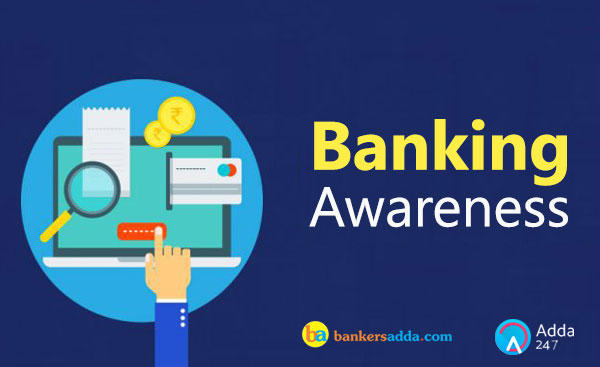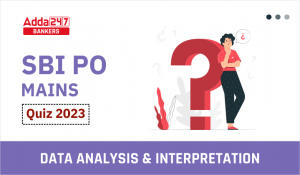Dear Aspirants,
Banking Awareness for Dena Bank PO Exam 2018
With the increased competition in the field of banking examinations, it has now become very important to cover up all the sections efficiently. One subject that can help you bagging graceful marks in the minimum time in these examinations is Banking Awareness. Banking Awareness Quiz not only helps you deal with the General Awareness Section of Banking Exams but also, the Personal Interview round of Banking Recruitment.
Q1. Which discussing investments there is mention of short-term government security? What is this type of investment known as?
(a) Debenture
(b) Mutual fund
(c) Treasury bill
(d) Share
(e) None of the given options is true
S1. Ans.(c)
Sol. Treasury Bills are short-term (up to one year) borrowing instruments of the Government of India which enable investors to park their short-term surplus funds while reducing their market risk. They are auctioned by Reserve Bank of India at regular intervals and issued at a discount to face value.
Q2. Which of the following schemes available in the financial markets is not meant for investment purposes?
(a) National savings certificates
(b) Infrastructure bonds
(c) Mutual funds
(d) Letter of credit
(e) None of the given options is true
S2. Ans.(d)
Sol. A letter of credit is a letter from a bank guaranteeing that a buyer’s payment to a seller will be received on time and for the correct amount. In the event that the buyer is unable to make payment on the purchase, the bank will be required to cover the full or remaining amount of the purchase.
Q3. Systematic Investment Plans are a customer-centric facility provided by which of the following?
(a) Mutual funds
(b) Stockbrokers
(c) Commercial banks
(d) Post office savings schemes
(e) None of the given options is true
S3. Ans.(a)
Sol. Systematic investment plan (full form of SIP) is an investment strategy offered by fund houses to investors, making it convenient to invest small sums of money in their mutual funds.
Q4. NBFCs are an important part of the Indian financial system. What is the full form of this term?
(a) New Banking Financial Companies
(b) Non-Banking Financial Companies
(c) Neo Banking Financial Confederation
(d) Non-Banking Fiscal Companies
(e) None of the given options is true
S4. Ans.(b)
Sol. NBFCs stands for Non-Banking Financial Companies.
Q5. What does the term ‘bancassurance’ mean?
(a) Assurance from the bank to its account holder regarding the safety of his money
(b) A special product designed by the bank
(c) Selling of insurance policies by banks
(d) The understanding between banks and insurance companies
(e) None of the given options is true
S5. Ans.(c)
Sol. Bancassurance means selling insurance product through banks. Banks and insurance company come up in a partnership wherein the bank sells the tied insurance company’s insurance products to its clients.
Q6. Which of the following is a non-banking financial company?
(a) SBI
(b) ICICI Bank
(c) Muthoot Finance Limited
(d) NABARD
(e) Standard Chartered Bank
S6. Ans.(c)
Sol. Muthoot Finance Ltd. is an Indian financial corporation. It is known as the largest gold financing company in the world. Muthoot Finance Ltd. is a NBFCs.
Q7. Which of the following is true?
(a) NBFCs can accept deposits from the public
(b) NBFCs cannot offer deposit schemes to the public
(c) Deposits of NBFCs are insured with DICGC
(d) NBFCs can accept deposits from the public if they are registered and permitted by RBI
(e) None of the given options is true
S7. Ans.(d)
Sol. NBFCs lend and make investments and hence their activities are akin to that of banks; however there are a few differences as given below:
i. NBFC cannot accept demand deposits;
ii. NBFCs do not form part of the payment and settlement system and cannot issue cheques drawn on itself;
iii. deposit insurance facility of Deposit Insurance and Credit Guarantee Corporation is not available to depositors of NBFCs, unlike in case of banks.
Q8. Till what amount are deposits of public in NBFCs insured?
(a) Rs. 1 lakh
(b) Rs. 50,000/-
(c) Not insured
(d) Rs. 10,000
(e) None of the given options is true
S8. Ans.(c)
Sol. The deposits with NBFCs are not insured.
Q9. Which of following institutions regulate non-banking financial companies?
(a) RBI
(b) SEBI
(c) IRDA
(d) Finance Ministry
(e) NABARD
S9. Ans.(a)
Sol. Financial activity as principal business is when a company’s financial assets constitute more than 50 percent of the total assets and income from financial assets constitute more than 50 percent of the gross income. A company which fulfills both these criteria will be registered as NBFC by RBI.
Q10. Which apex body regulates insurance companies in India?
(a) RBI
(b) IRDAI
(c) PERDA
(d) SEBI
(e) NABARD
S10. Ans.(b)
Sol. Insurance Regulatory and Development Authority of India (IRDAI), is a statutory body formed under an Act of Parliament, i.e., Insurance Regulatory and Development Authority Act, 1999 (IRDAI Act 1999) for overall supervision and development of the Insurance sector in India.
Q11. There is a possibility of account holders retaining the same bank account number even when banks are being changed. What is this facility known as?
(a) Number portability
(b) Deposit portability
(c) Bank portability
(d) Account number portability
(e) None of the given options is true
S11. Ans.(d)
Sol. Account Number Portability (ANP) is generally referred to as the ability of a customer to move to another current account providers while retaining the same account details.
Q12. What is the role of a third-party administrator in a medi claim policy?
(a) Approves the list of hospitals whose bills are acceptable
(b) Scrutinizes the bills submitted by the policyholder for reimbursement
(c) Does audit work for the insurance companies
(d) Arranges for the issue of policies after verification of application form
(e) None of the given options is true
S12. Ans.(b)
Sol. Scrutinizes the bills submitted by the policyholder for reimbursement.
Q13. Just like banks have to maintain a stipulated capital adequacy ratio similarly non-banking finance companies NBFCs are also required to do so. What is the minimum stipulation for NBFCs with asset size of Rs.100 crore and above?
(a) 15 percent
(b) 12 percent
(c) 10 percent
(d) 8 percent
(e) 30 percent
S13. Ans.(a)
Sol. At present, all NBFCs with asset size of Rs.100 crore and above are required to have minimum CRAR of 15%.
Q14. Which body/official determines the risk coverage for calculation of premium for life insurance policies?
(a) Actuary of the life insurance company
(b) IRDAI
(c) The chief executive of the life insurance company
(d) The board of directors of the life insurance company
(e) None of the given options is true
S14. Ans.(a)
Sol. Actuary of the life insurance company determines the risk coverage for calculation of premium for life insurance policies.
Q15. RuPay payment system is a major initiative in the banking sector in India. What is its contribution?
(a) It is an Indian payment system for debit cards
(b) It is a clearinghouse for payments
(c) It is meant for implementation of cheque truncation services
(d) It scrutinizes retail loan applications
(e) None of the given options is true
S15. Ans.(a)
Sol. RuPay payment system is an Indian payment system for debit cards.





 Quantitative Aptitude Quiz For SBI PO Ma...
Quantitative Aptitude Quiz For SBI PO Ma...
 Inequalities Basic Reasoning Quiz for Al...
Inequalities Basic Reasoning Quiz for Al...



